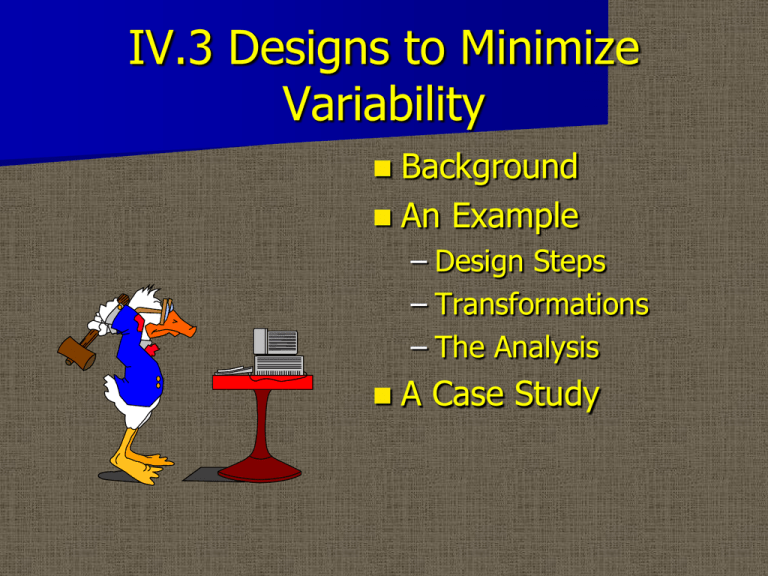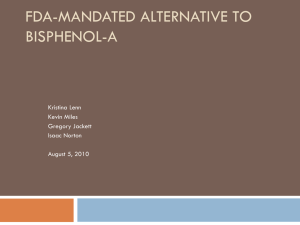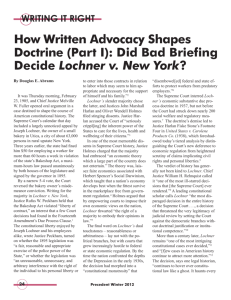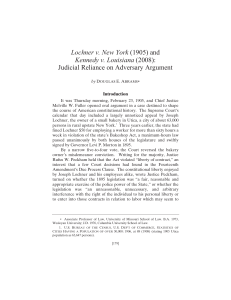IV.3 Designs to Minimize Variability
advertisement

IV.3 Designs to Minimize Variability Background An Example – Design Steps – Transformations – The Analysis A Case Study Background Accuracy/Precision Factors Can Affect Response Variable by Either – Changing Its Average Value (Accuracy) – Changing Its Variation (Precision) or – BOTH Background Example 4 - Example I.2.3 Revisited Which Factors Affect – Accuracy? – Precision? 1 2 Background Analysis for Changes in Variability For studying Variability, we can use ALL the designs, ALL the ideas that we used when studying changes in mean response level. However, – Smaller Variability is ALWAYS better – We MUST work with replicated experiments – We will need to transform the response s Example 5 Mounting an Integrated Circuit on Substrate Figure 5 - Factor Level Lochner and Matar - Figure 5.11 Response: bond strength Factor A. Adhesive Type B. Conductor Material C. Cure Time (at 90C) D. I.C. Post Coating Low Level D2A Copper 90 min. Tin High Level H-1-E Nickel 120 min. Silver Example 5 - Design Steps Selecting the Design Figure 6 - The Experimental Design Lochner and Matar - Figure 5.12 1. Select an appropriate experimental design Standard Order 1 2 3 4 5 6 7 8 Adhesive Type D2A D2A D2A D2A H-1-E H-1-E H-1-E H-1-E Conductor Material copper copper nickel nickel copper copper nickel nickel Cure Time 90 120 90 120 90 120 90 120 I.C. Post Coating tin silver silver tin silver tin tin silver Example 5 - Design Steps Replication and Randomization 2. Determine number of replicates to be used – Consider at Least 5 (up to 10) – In Example 5: 5 replicates, 40 trials 3. Randomize order of ALL trials – Replicates Run Sequentially Often Have Less Variation Than True Process Variation – This May Be Inconvenient! Example 5 - Design Steps Collecting the Data Figure 7 - The Data Lochner and Matar - Figure 5.13 4. Perform experiment; record data 5. Group data for each factor level combination and calculate s. Standard Order 1 2 3 4 5 6 7 8 y1 73.0 87.7 80.5 79.8 85.2 78.0 78.4 90.2 y2 73.2 86.4 81.4 77.8 85.0 75.5 72.8 87.4 y3 72.8 86.9 82.6 81.3 80.4 83.1 80.5 92.9 y4 72.2 87.9 81.3 79.8 85.2 81.2 78.4 90.0 y5 76.2 86.4 82.1 78.2 83.6 79.9 67.9 91.1 y 73.48 87.06 81.58 79.38 83.88 79.54 75.60 90.32 s 1.57 0.71 0.80 1.41 2.06 2.93 5.17 1.99 Log(s) 0.196 -0.149 -0.097 0.149 0.314 0.467 0.713 0.299 Example 5 - Design Steps The Analysis 6. Calculate logarithms of standard deviations obtained in 5. Record these. 7. Analyze log s as the response. Transformations Why transform s? If the data follow a bell-shaped curve, then so do the cell means and the factor effects for the means. However, the cell standard deviations and factor effects of the standard deviations do not follow a bell-shaped curve. If we plot such data on our normal plotting paper, we would obtain a graph that indicates important or unusual factor effects in the absence of any real effect. The log transformation ‘normalizes’ the data. Transformations Distributions and Normal Probability Plots of s2 and Log(s2) 0.20 0.60 Sam pling from Norm al Sam pling from Norm al (n =5 si gma=1 ) (n =5 si gma=1 ) 0.10 0.30 0.00 0.00 0.0 3.0 6.0 9.0 12.0 -1.0 0.0 1.0 2.0 3.0 2.5 2.5 40 obser vatio ns of s 0.0 x x x x x x xxx xx xx xx x xxx xx x xx x x xxx x x x x 2 x xx xx x x x 2 40 obser vatio ns of Log s 0.0 x x x x x x xx xx xx xx xx xx x x xx x x x x x x x xx xxx x x x x -2.5 -2.5 0.0 2.0 4.0 6.0 8.0 -0.80 0.00 0.80 1.60 2.40 Example 5 - Analysis Figure 8 - Response Table for Mean Lochner and Matar - Figure 5.14 Standard Order Sum Divisor Effect y A B C AB Bond Strength Adhesive Type Conductor Material Cure Time AC BC D IC Post Coating 1 73.48 -1 -1 -1 1 1 1 -1 2 83.88 1 -1 -1 -1 -1 1 1 3 81.58 -1 1 -1 -1 1 -1 1 4 75.6 1 1 -1 1 -1 -1 -1 5 87.06 -1 -1 1 1 -1 -1 1 6 79.54 1 -1 1 -1 1 -1 -1 7 79.38 -1 1 1 -1 -1 1 -1 8 90.32 1 1 1 1 1 1 1 650.84 7.84 2.92 21.76 2.08 -1 3.28 34.84 8 4 4 4 4 4 4 4 81.355 1.96 0.73 5.44 0.52 -0.25 0.82 8.71 Example 5 - Analysis Figure 9 - Response Table for Log(s) Lochner and Matar - Figure 5.15 Standard Order Sum Divisor Effect y A B C AB Log(s) Adhesive Type Conductor Material Cure Time AC BC D IC Post Coating 1 0.196 -1 -1 -1 1 1 1 -1 2 0.314 1 -1 -1 -1 -1 1 1 3 -0.097 -1 1 -1 -1 1 -1 1 4 0.713 1 1 -1 1 -1 -1 -1 5 -0.149 -1 -1 1 1 -1 -1 1 6 0.467 1 -1 1 -1 1 -1 -1 7 0.149 -1 1 1 -1 -1 1 -1 8 0.299 1 1 1 1 1 1 1 1.892 1.694 0.236 -0.36 0.226 -0.162 0.024 -1.158 8 4 4 4 4 4 4 4 0.2365 0.4235 0.059 -0.09 0.0565 -0.041 0.006 -0.2895 Example 5 - Analysis Figure 10 - Effects Normal Probability Plot for Mean What Factor Settings Favorably Affect the Mean? Example 5 - Analysis Figure 11 - Effects Normal Probability Plot for Log(s) Lochner and Matar - Figure 5.16 What Factor Settings Favorably Affect Variability? Example 5 - Interpretation Silver IC post coating increases bond strength and decreases variation in bond strength. Adhesive D2A decreases variation in bond strength. 120-minute cure time increases bond strength. Case Study 1 Filling Weight of Dry Soup Mix - Factors and Response Factor Low A: Number of Ports B: Cooling M ethod C: M ixing Time (se cs) D: Batch we ight (lbs) E: Delay (days) High 1 Water coole d 60 1500 1 3 Air cooled 80 2000 7 Re sponse : Weight of packe t conte nts (oz) A 1 1 1 1 1 1 1 1 2 2 2 2 2 2 2 2 B 1 1 1 1 2 2 2 2 1 1 1 1 2 2 2 2 C 1 1 2 2 1 1 2 2 1 1 2 2 1 1 2 2 D 1 2 1 2 1 2 1 2 1 2 1 2 1 2 1 2 E 2 1 1 2 1 2 2 1 1 2 2 1 2 1 1 2 Log(s) -.0132 .2672 .0719 -.1192 .0531 -.1079 .1673 .0374 .2304 -.2076 -.0088 .3222 .0969 .1335 .1072 .0414 Case Study 1 Filling Weight of Dry Soup Mix - Effects Table Interpret This Data – Determine the Important Effects – Do the Interaction Tables and Plots for Significant Interactions Effect A B C D E AB AC AD AE BC BD BE CD CE DE Value 0.04482 -0.00175 0.02088 -0.04222 -0.17175 0.01245 0.03132 0.00818 -0.04610 0.02355 -0.03780 0.13837 0.02828 0.05725 -0.11665










